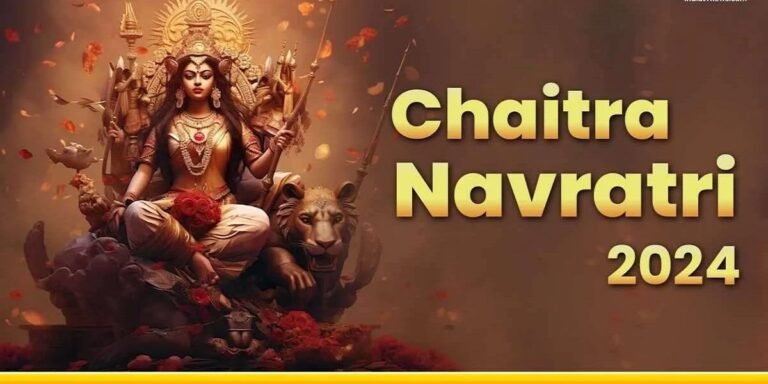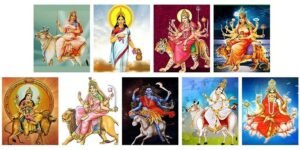Navratri 2024: Celebrating the Nine Divine Forms of Goddess Durga

Navratri 2024: Celebrating the Nine Divine Forms of Goddess Durga
Navratri, a vibrant and joyous festival celebrated by Hindus all around the world, holds great significance. It is a nine-night festival that honors the nine divine forms of Goddess Durga. Each form, known as a “manifestation” or “avatar,” represents different aspects of the goddess. During Navratri, devotees offer prayers, perform rituals, and seek blessings from these forms of Maa Durga.
The Nine Divine Forms of Goddess Durga
Let’s delve into the nine divine forms of Goddess Durga that are worshipped during Navratri:

Maa Shailputri
Maa Shailputri, the first form of Goddess Durga, is worshipped on the first day of Navratri. She is believed to be the daughter of the Himalayas, hence the name “Shailputri.” She is depicted with a trident in her right hand and a lotus flower in her left hand. Devotees seek her blessings for strength and stability in their lives.
Maa Brahmacharini
Maa Brahmacharini, the second form of Goddess Durga, is worshipped on the second day of Navratri. She is associated with penance and knowledge. Devotees believe that by worshipping her, they can attain spiritual wisdom and enlightenment. Maa Brahmacharini is depicted as holding a rosary in her right hand and a water utensil in her left hand.
Maa Chandraghanta
Maa Chandraghanta, the third form of Goddess Durga, is worshipped on the third day of Navratri. She is known for her bravery and courage and is believed to ward off evil and negativity. Maa Chandraghanta is depicted with ten hands, holding various weapons and riding a tiger. Devotees seek her blessings for protection and fearlessness.
Maa Kushmanda
Maa Kushmanda, the fourth form of Goddess Durga, is worshipped on the fourth day of Navratri. She is believed to have created the universe with her divine smile. Maa Kushmanda is depicted with eight hands, holding weapons, rosary, and a lotus flower. Devotees seek her blessings for health, wealth, and prosperity.
Maa Skandamata
Maa Skandamata, the fifth form of Goddess Durga, is worshipped on the fifth day of Navratri. She is the mother of Lord Skanda or Kartikeya, the commander-in-chief of the divine army. Maa Skandamata is depicted holding Lord Skanda in her lap and has four hands. Devotees seek her blessings for nurturing and protecting their children.
Maa Katyayani
Maa Katyayani, the sixth form of Goddess Durga, is worshipped on the sixth day of Navratri. She is known for her fierce and warrior-like nature. Maa Katyayani is depicted with four hands, holding a sword, lotus flower, and a shield. Devotees seek her blessings for courage, strength, and marital bliss.
Maa Kaalratri
Maa Kaalratri, the seventh form of Goddess Durga, is worshipped on the seventh day of Navratri. She is the most fierce and destructive form of the goddess. Maa Kaalratri is depicted with a dark complexion and four hands, holding a sword and a noose. Devotees seek her blessings for protection from evil forces and to overcome fear.
Maa Mahagauri
Maa Mahagauri, the eighth form of Goddess Durga, is worshipped on the eighth day of Navratri. She is known for her beauty and purity. Maa Mahagauri is depicted with four hands, holding a trident and a drum. Devotees seek her blessings for peace, prosperity, and spiritual growth.
Maa Siddhidatri
Maa Siddhidatri, the ninth and final form of Goddess Durga, is worshipped on the ninth day of Navratri. She is believed to possess and bestow all types of Siddhis (supernatural powers). Maa Siddhidatri is depicted with four hands, holding a lotus flower, mace, discus, and conch shell. Devotees seek her blessings for success, knowledge, and fulfillment of desires.
Devotees and Their Prayers
During Navratri, devotees observe fasts, perform traditional dances like Garba and Dandiya, and visit temples to offer prayers to the nine forms of Goddess Durga. The festival is not just about celebration; it is a time for spiritual reflection, devotion, and seeking blessings.
Devotees pray to each form of Maa Durga, seeking her divine grace and guidance. They believe that by worshipping these forms, they can overcome challenges, attain spiritual growth, and lead a blessed life.
It is believed that each form of Maa Durga represents different aspects of femininity, strength, and wisdom. By honoring these forms during Navratri, devotees acknowledge and celebrate the divine feminine energy that resides within them and in the universe.
In Conclusion
Navratri is a time to rejoice, connect with the divine, and seek blessings from the nine divine forms of Goddess Durga. Each form holds significance and represents different aspects of the goddess. Devotees offer prayers, perform rituals, and immerse themselves in the festivities to experience spiritual growth, peace, and prosperity.
May this Navratri bring joy, happiness, and blessings to all!